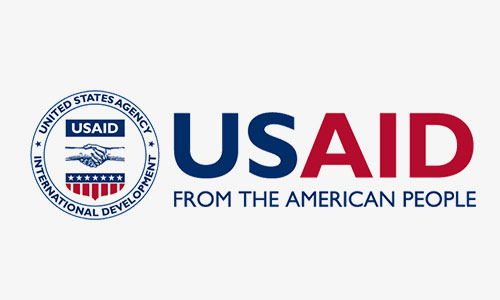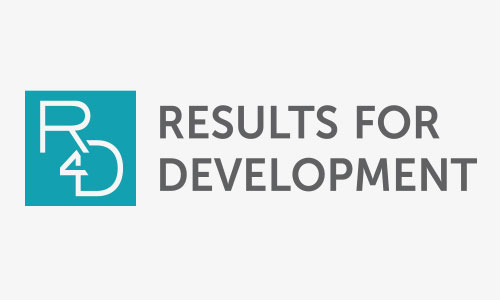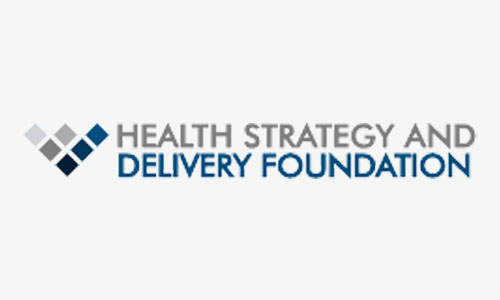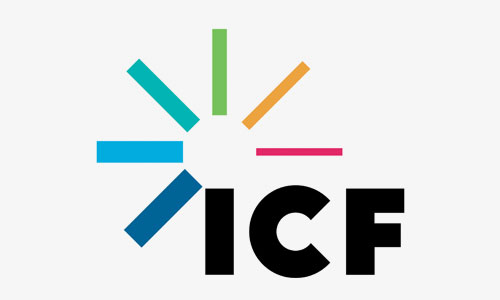Authors: Emily Adams, Kéfilath Bello, Nathan Blanchet, Jean-Paul Dossou, Aboubakar Issa, Lior Miller, Cicely Thomas, and Cheickna Toure
As Togo’s government seeks to improve its national universal health coverage (UHC) roadmap, “co-creation” emerged as a promising approach for multi-sectoral stakeholders to validate systems challenges, discuss root causes, and create effective solutions together, while building trust and buy-in. Co-creation promotes innovation through participatory approaches that bring together diverse stakeholders, contextualized analysis, and shared decision-making and responsibility. But what happens when it is no longer possible to co-create in person? This blog describes how we adapted co-creation, mentoring, coaching, and collaborative learning approaches during COVID-19 to strengthen UHC in Togo.
Co-creation preparation and planning
Togo has a national roadmap to guide them towards equitable, accessible, and high-quality UHC for all, but this framework has yet to be fully implemented. Prior to COVID-19, Togolese UHC leaders and champions at the Ministry of Health and the Directorate of Social Protection conceptualized a 3-day in-person co-creation process to strengthen implementation of the existing UHC roadmap, in collaboration with the Health Systems Strengthening Accelerator (Accelerator), the African Collaborative for Health Financing Solutions (ACS), and regional partner CERRHUD (Centre de Recherche en Reproduction Humaine et en Démographie).
Preparation for the workshops began with an in-person in-depth situational analysis involving one on one discussions, outreach, and scoping visits with key stakeholders to understand the context, unpack challenges and opportunities, and identify the right players to involve in the process led by our local and regional coaches. The situational analysis also included a review of key literature, policies, and documentation on UHC in Togo. It provided framing of the issues and preliminary analysis of the root causes leading into the co-creation workshops and served as a resource for participants.
However, this preparatory work quickly ground to a halt as the COVID-19 pandemic emerged and it became clear that in-person convenings would no longer be feasible. R4D’s Nathan Blanchet wrote about this new challenge and proposed a solution that would “flatten a different curve”: by using technology and spreading the functions of a co-creation workshop over weeks or months instead of days, he imagined that we could still achieve many of the same goals virtually.
Togo Co-Creation in Numbers
- 30-50 participants per session
- 20+ institutions, Ministries, and partners represented
- 8-12 facilitators/note-takers per session
- 6 sessions spread across several weeks
- 4 priority themes to achieve UHC identified
- 1 country-owned action plan drafted
Virtual adaptation
The first adaptation was timing – we certainly could not expect participants to spend three full days glued to their computer screens. We decided to break up the workshop into four co-creation sessions lasting 2.5 hours each and spread out over a one-month period. We also held two additional sessions for members of a multi-sectoral task force to finalize the UHC action plan.
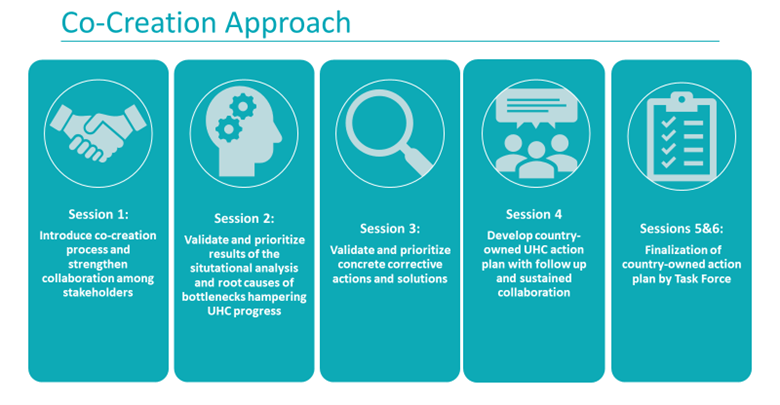
We knew that the virtual nature of the workshop would introduce new logistical challenges, so we created a detailed facilitation guide to ensure the sessions ran smoothly. We also did significant pre-work with the participants to efficiently utilize our limited time during the sessions. Our coaches (local consultant and regional partner CERRHUD) worked with directors within the Ministry of Health and Directorate of Social Protection to act as mobilizing champions by encouraging high levels of participation, raising the visibility of the co-creation process, and leading each session. We also reimbursed internet expenses to prevent Wi-Fi costs from being a prohibitive cost for participation.
During the first workshop, we began with a brief technology overview to ensure that everyone was comfortable with Zoom’s features. During the breakout sessions, real-time notetaking on a facilitator’s shared screen took the place of a whiteboard or sticky notes and allowed participants to build upon what had already been shared by their colleagues.
We regularly reinforced the material of each session and how it fit in with the broader co-creation process, reviewing our progress at the beginning of each session. The follow-up, both virtual and over the phone, via our in-country facilitator, helped maintain momentum and excitement, and sustain participation levels. The follow-up also included outreach of higher-level government officials who could help build government commitment.
In the table below, we compare how the ten essential functions of co-creation originally distilled in Blanchet’s blog were achieved in a fully virtual environment.
Key adaptations for shifting effectively from in person to virtual co-creation
- Spreading the workshop over time
- In-depth situational analysis beforehand to identify key challenges
- Innovative and multidisciplinary engagement process with mobilizing champions
- Use of online collaborative working tools to support collective root cause analysis and brainstorming on possible solutions
- Refinement of action plan by self-selected Task Force
- Sharing of identified bottlenecks with higher-level stakeholders
- Continuous dialogue between actors throughout the entire process, steered by in-country facilitators
Defining a problem and identifying key stakeholders
In-person Delivery
Conducting in-person scoping and planning meetings in order to develop a concept note and an invitation list
Togo Virtual Delivery
Extensive pre-workshop preparation and planning. Conducting an in-depth situational analysis to understand the problem. Initially validating findings with key Ministry champions. Conducting virtual outreach (email, phone calls) in order to finalize a concept note and a stakeholder list—now unconstrained by venue space/budget
Designing a process for problem analysis and co-creation
In-person Delivery
Developing an agenda for an in-person meeting
Togo Virtual Delivery
Developing a detailed facilitation guide—similar to “run sheets” or other run of show templates—for virtual co-creation process
Raising awareness of key issues and approaches
In-person Delivery
Provide packet of readings and live presentations
Togo Virtual Delivery
Share readings in advance and present key issues drawn from a situational analysis
Conducting root cause analysis and formulating solutions with diverse voices
In-person Delivery
Designing large group or break-out activities to “unpack” challenges and begin to co-create solutions while ensuring all stakeholders are engaged
Togo Virtual Delivery
Conducting upfront root cause analysis through an in-depth situational analysis and iterative stakeholder consultation before the workshop and validating and expanding on these during the virtual workshop.
Co-creating solutions in breakout groups and discussing them in plenary.
Pointing out the elephant in the room
In-person Delivery
Using in-person facilitation methods that diplomatically raise and navigate sensitive issues
Togo Virtual Delivery
Presentation by local facilitators and experts on identified strengths and weaknesses of current UHC roadmap
Building trust and solidarity
In-person Delivery
Icebreakers, coffee break chats, group photo Tweeted to the world
Togo Virtual Delivery
Virtual icebreakers, regular communication with a local facilitator, creating opportunities for new connections within breakout room sessions, and “family photo” taken of participants’ video feeds on Zoom
Demonstrating a problem or innovation
In-person Delivery
Site visit
Togo Virtual Delivery
Participants shared concrete examples related to the challenges that were discussed. For example, to illustrate lack of political engagement for UHC, participants debated how the national health insurance scheme, a highly-supported initiative, happened quickly whereas the less-visible UHC roadmap was implemented more slowly
Building consensus and setting priorities
In-Person Delivery
Having group report-outs, plenary discussion, sticky-note voting or other means
Togo Virtual Delivery
Zoom poll voting, live note-taking on shared screen, breakout group report-outs and plenary sessions
Joint work planning
In-Person Delivery
Completing workplan templates with facilitator support
Togo Virtual Delivery
Self-selected Task Force completing workplan templates with facilitator support
Following up and ensuring actions are taken and connections continue
In-Person Delivery
Too often missing?
Togo Virtual Delivery
Following up with notes and takeaways after each workshop; sharing Task Force-created workplans with broader stakeholder group; continuing communication from in-country facilitator
Reflections and lessons
Based on the experience from the Accelerator’s co-creation process in Togo, it is indeed possible for virtual co-creation to achieve many of the same goals as an in-person workshop, given appropriate adaptations to the local context. Not only did the process in Togo successfully engage a variety of stakeholders in the creation of a UHC action plan, it also succeeded in beginning the process of getting buy-in from the highest levels of government—including Togo’s new Delegated Minister for UHC, who was appointed in the middle of the co-creation process. One participant expressed that “the main utility of this workshop was in remobilizing the key actors and restarting a process which started a long time ago, but which had broken down.”
In the coming months, it is worth reflecting on what aspects of this virtual co-creation approach we would keep, even after the world returns to “normal.” Should co-creation become a hybrid model? This could allow some participants to be in the room and others spread across the country or even world. Hybrid models could create more opportunities for knowledge exchange; for example, by inviting a government official from another country that had success (or failure) with a similar challenge, stakeholders in the co-creation session could learn from past experiences and existing global knowledge. Similarly, this could provide more opportunities to involve people from remote areas, provided a small investment for their internet access. It is also worth considering if co-creation workshops should take the form of longer, spread out processes that take place over weeks or months rather than days. This longer approach could foster sustained excitement and engagement, provide more time to build trust and lasting linkages between stakeholders, and, ultimately, bolster countries’ endeavors toward UHC.
